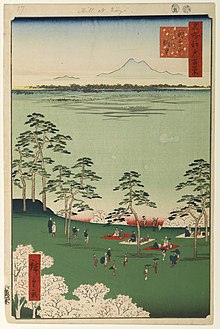Asukayama Park

The Asukayama Park ( Japanese 飛鳥 山 公園, Asukayama Kōen ) is a public park in the Kita district (Tokyo) .
history
The name of the hill in the Ōji district is said to be derived from the fact that Toshima Kagemura (豊 島 景 村), a general during the Namboku period, in the Genkō era (元亨; 1321-1324) there the Asuka shrine of Kumano (熊 野 飛鳥 祠) in the province of Kii . The 8th Shogun Tokugawa Yoshimune had more than 1000 mountain cherry trees planted on the hill, making the Asukayama, next to Ueno in the east of the city, the most important place for the cherry blossom festival. The common folk in particular could enjoy themselves there.
In the 1723 guide to the sights of Edo, the "Edo Sunago" (江 戸 砂子) - something like "Grains of sand in Edo", it says: "On the Asakayama (朝 香山) the spirit of the Ōji (王子 権 現, Ōji Gongen) is revered. Several thousand cherry trees have been planted recently by the government, which makes for a beautiful view. "
The cherry trees that were planted at the time only bloomed for an extremely short period of time, just before the rice-sowing began. It is possible that Shogun Yoshimune, also known as the "rice shogun", intended to invite the farmers to rest before the hard work of sowing them began. Other shoguns continued the tradition of this encouragement.
The attachment
The Asukayama, at the foot of which a railway line now runs along the northeast side, was converted into a park in 1873, making it one of the first six public parks in Tokyo. In the park is the Asukayama memorial stone, which was erected in 1737, the Ōbu memorial stone (桜 賦 碑) for Sakuma Shōzan , a politically active scholar of the late Edo period, and for Funatsu Denjibee (船津 伝 次 兵衛; 1832–1898) , one of the “Three Agricultural Researchers of the Near Present”.
Also on the edge of the park is the mansion of the entrepreneur Shibusawa Eiichi (1840–1931), a western-style building. The 18th President of the United States, Ulysses S. Grant , who stayed in the country for two months in 1873, Chiang Kai-shek , who received military training in Tokyo in 1906, Rabindranath Tagore in March 1924 and many other. The building now functions as a library under the name “Seien Bunko” (青 淵 文庫). A Shibusawa's pavilion called "Bankōro" (晩 香 盧) can be visited.
With the paper museum of the Ōji paper mill, “Kami no hakubutsukan” (紙 の 博物館), the “Shibusawa Shiryōkan” (渋 沢 資料 館) and the newly built “Asukayama Hakubutsukan” (飛鳥 山 博物館) there are three museums next to each other in the park .
photos
Woodcut with hanami
Remarks
- ↑ View to the northeast: in the background you can see Mount Tsukuba . It is sheet 17 from the series 100 famous views of Edo .
literature
- Tokyo-to rekishi kyoiku kenkyukai (Ed.): Asukayama Koen . In: Tokyo-to no rekishi sampo (chu). Yamakawa Shuppan, 2005. ISBN 978-4-634-24713-0 . P. 178.
Web links
Coordinates: 35 ° 45 ′ 2 ″ N , 139 ° 44 ′ 20 ″ E





